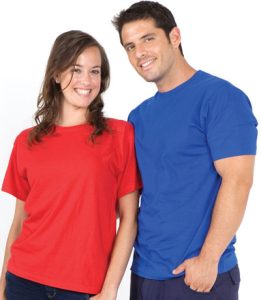We offer a full printing service specialising in screen printing.
Our screen printing production capacity is 10,000 shirts per day.
The more you screen print the cheaper the unit price.
To be able to offer you our best screen printing price, we will first need to see your artwork.
There are 6 factors that govern the cost of printing Tshirts.
1) The colour of the Tshirt. (it is cheaper to print on white shirts than coloured shirts)
2) the number of colours in your image. (the more colours the more expensive)
3) the quantity. (the more you print the cheaper the unit price)
4) the number of different positions on the shirt. (the more positions the more expensive)
5) shirt material (100% cotton, 100% polyester of cotton poly blends)
6) your required size range (do you want kids and adults or just adults only)
We offer all styles of printing, including ;
* Screen Printing
* Digital Printing
* Sublimation
* Discharge prints
* Foil, Metallic, Glitter, Glow in the Dark, Flocking, Rhinestones, Puff
* Embroidery
* Vinyl printing
* Iron On heat Transfers
Artwork : High res image
(300dpi resolution) A) Illustrator B) EPS, C) PDF D) PSD Photoshop F) PNG G) JPG
To Quote please advise :
The colour of T-shirt you want to print on, It is cheaper to print on “white” T-shirts than “black” or “coloured” shirts.
How many colours in each image you would like to print. If you are unsure of the number of colours, just email your image to us.
How many different position for each screen printing image, e.g
- Front – Centre Chest or Left breast logo,
- Back – across shoulder or centre back
- Sleeve – left or right
- Side – left or right.
Guide to Screen Printing
The earliest record of Screen Printers firsts dates back to the Chinese Song Dynasty (960-1279 AD)
The quality of a Screen–print will depend on the mesh count of the screen
- 25 to 40 mesh count. – glitter and or shimmer inks
- 60 mesh count – heavy ink deposit
- 80 – 86 mesh count – is often used in making screen printed transfers
- 110 to 160 mesh count – lower scale is ideal for underbase or printing bold colours, while higher scale mesh are ideal for printing more detailed designs.
- 180 to 200 mesh count – ideal for high detail screen-prints.
- 230 to 280 mesh count – high detail but low ink deposit.
T shirt screen printing can be done as a small hobby or big businesses, depending on your personal target.
T shirt printing is easy to do. Tshirt printing is a major vehicle in marketing and promotions, to convey a message or artist expression, whatever it might be.
- Tshirts – it is best to find a local importer who can supply stock at hand
- frames – can be made from wood and or aluminium
- mesh – the quality of the print will be determined by your mesh size.
- emulsion – source from a local supplier
- inks – source from a local supplier
- wash up areas – garden hose
- work space – garage or spare room dark


